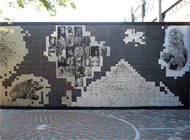 |
| CLICK
IMAGE for views of mural. |
|
 |
| Rimer
Cardillo |
| Environment
and Culture: From the Amazon to the Hudson River Valley |
| Humanities
Building Excelsior Concourse |
| State
University of New York at New Paltz, New Paltz, NY |
Between
the Graphic and Tectonic: Architecture, Mapping, and Topography
in Rimer Cardillo’s Works
Viktoria
Villanyi
The
following essay is about the interaction of architecture and printmaking,
and their combined role in the formation of meaning in Rimer Cardillo’s
most recently finished silkscreen wall mosaic, Environment and Culture:
From the Amazon to the Hudson River Valley, permanently installed
on the Humanities Building along the Excelsior Concourse of the
SUNY New Paltz campus.[1] The large-scale
images that are distributed randomly over the mural’s geometric
grid have been previously interpreted, and classified, by contemporary
art critics according to their visual function as icons, specifically,
as the symbols of the South American landscape, culture, and cultural
heritage.[2] There has been little attention paid to how the structural
arrangement, within a two dimensional plane, and within the full
architectural body, alters the function and the meaning of these
images. I will therefore begin this essay by outlining how Cardillo
deconstructs and then layers the meaning of these icons through
his integration of the mural’s architectural design in its
immediate environment, the university campus. Then I locate his
deconstructive method, with its similarities and divergences, in
the aesthetic tradition of Joaquin Torres-Garcia, a muralist, and
formative figure in the art and culture of twentieth century Uruguay.[3]
In the second and main part of the paper I show how Cardillo applies
structural shifts, displacement, re-sequencing to the so-called
"iconic" motifs of landscapes and buildings in his prints
as well as in his architectural installations, to deconstruct the
symbols of fixed national, cultural or historical identity, to create
from them a cognitive discourse on transnational experience. (continued)
[Click
here for entire essay]
|
|